Heel Brake Tutorial
Here's an overview of what you'll learn at our free Stopping Clinics. To get the most out of this information you should do this under the direction of a certified instructor. Always wear your protective gear, including wrist guards and a helmet.
| |
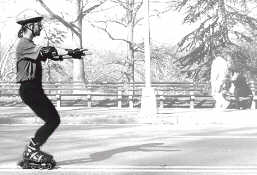
Step 1: Ready Position
|
Step 1: The "Ready" Position
In the ready position your skates are a few inches apart, parallel, and facing forward. Your knees are bent, your back is straight, and your arms are extended in front of you.
It's okay to lean forward slightly to keep your balance but keep in mind that ultimately you want most of your weight to be behind the brake, not in front of it.
It's important to extend your arms for two reasons: 1) to keep from falling backward, and 2) to catch yourself in case you fall forward.
| |
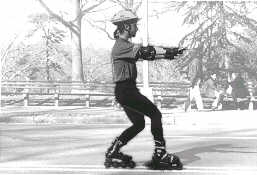
Step 2: Roll your right foot forward
|
Step 2: Roll your braking foot forward
If you're tall or have especially long legs you may also need to roll your non-braking foot slightly backward (but only an inch or two) to prevent yourself from falling backward.
Resist the urge to raise your right toe. This will cause the brake to engage too early and won't give you much leverage.
| |
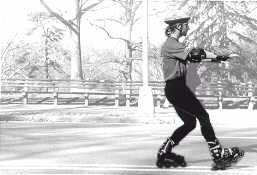
Step 3: Raise your right toe
|
Step 3: Raise the toe of your braking skate
The amount you'll have to lift your toe depends on how high the brake is from the ground to begin with. If your skates have the ABT brake this step may not be necessary because the ABT should engage as you slide your braking foot forward.
Common Braking Mistakes
| |
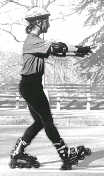
Don't lock your knees!
|
- Not bending your knees enough
- Problem: If you don't bend your knees enough, you will be unstable and your heel brake will work inefficiently.
- Solution: Don't lock your knees. Instead, keep them slightly bent. Bending your knees does two things: it lowers your center of gravity (thus making you more stable), and lets you slide your braking skate well in front of your other skate.
| |
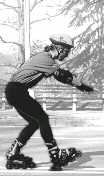
Don't lean forward!
|
- Leaning too far forward
- Problem: If you lean forward your brake won't work. By leaning forward, you're putting your weight over (or, worse, in front of) your heel brake.
- Solution: Instead of leaning forward, you should keep your back fairly straight and just sit your rear end closer to the ground. Your weight should be centered slightly BEHIND your heel brake. Hint: DON'T look down; DO look forward.
- The more I tell people to bend their knees, the more they lean forward. As a result, every time I say, "Bend your knees!" I have to follow immediately with, "Don't lean forward! You're a skater, not Superman!"
| |
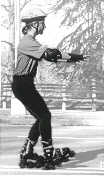
Don't lift your toe too early!
|
- Not scissoring your legs sufficiently
- Problem: If you don't scissor your legs enough, you will tend to fall forward or backward. ("Scissoring" means sliding your braking leg forward and your other leg backward, similar to the motion made by scissor blades opening.)
- Solution: As you slide your braking foot forward, avoid lifting your toe (and thus engaging the brake) too early. You may have to bend your knees more to keep your toe down.
- After you scissor your legs, the heel of your braking skate should be approximately 6 inches in front of the toe of your other skate. This gives you stability, much as a bicycle (with one wheel in front of the other) is more stable than a unicycle.
| |

Don't lean on your left skate!
|
- Leaning on the non-braking skate
- Problem: If you put too much weight on your non-braking skate, you will tend to turn in the direction of your braking skate (usually the right) rather than stopping.
- Solution: Most of your weight should be on your braking skate. Beginners find it natural to avoid putting weight on the braking foot, since it feels as if it won't hold their weight as they slide it forward. One of the biggest challenges in learning to use the heel brake involves overcoming the urge to take your weight off your braking skate. Despite what it feels like, your braking skate can--and should--hold your weight.
- To ensure your weight is over the braking skate, make sure your feet start as close as possible to each other left-to-right. They should be almost touching. When you slide your braking foot forward, make sure it goes forward, and not out to the side. Your feet should end up in nearly a straight line.
| |

Don't spread your legs apart!
|
- Planting your feet too wide
- Problem: If you spread your legs too wide you won't be able to put as much weight as possible on the braking skate.
- Solution: Don't spread your legs. This makes you unstable. Instead, place your skates as close together as possible, like you're balancing on a narrow plank. To ensure your weight remains behind the braking skate, keep your feet in a narrow line when you roll your braking foot forward, and make sure it really goes forward, not out to the side. Your feet should end up in nearly a straight line--again, as if you're skating on a plank.
WARNING: UNDER NO CIRCUMSTANCES SHOULD YOU ATTEMPT THESE MANEUVERS WITHOUT WEARING PROTECTIVE GEAR (INCLUDING BUT NOT LIMITED TO AN ANSI-CERTIFIED HELMET, WRIST GUARDS, ELBOW PADS, AND KNEE PADS) AND WITHOUT THE SUPERVISION OF A CERTIFIED INSTRUCTOR! PROTECTIVE GEAR AND SUPERVISION STILL DOESN'T GUARANTEE THAT YOU WON'T GET HURT, SO EXERCISE CAUTION AND SKATE AT YOUR OWN RISK!
NEW:For an Italian version of this tutorial see webmaster@skatepatrol.org.
What do you think of this tutorial? Was it helpful? Would you like to see something added? I'd like to know! Email your comments to webmaster@skatepatrol.org.
Photos copyright © 1997 by Paula Crivelli. Thanks to Robert Schmunk for enhancing the images.

